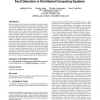20 search results - page 2 / 4 » A New Component Concept for Fault Trees |
SAFECOMP
1999
Springer
13 years 8 months ago
1999
Springer
Abstract. This paper introduces a new method for safety analysis called HiPHOPS (Hierarchically Performed Hazard Origin and Propagation Studies). HiP-HOPS originates from a number ...
ISCA
2000
IEEE
13 years 9 months ago
2000
IEEE
Smaller feature sizes, reduced voltage levels, higher transistor counts, and reduced noise margins make future generations of microprocessors increasingly prone to transient hardw...
INFOCOM
2008
IEEE
13 years 11 months ago
2008
IEEE
—We introduce Zen, a new resource allocation framework that assigns application components to node clusters to achieve high availability for partial-fault tolerant (PFT) applicat...
SIGMOD
2005
ACM
14 years 4 months ago
2005
ACM
We describe an approach for pipelining nested data collections in scientific workflows. Our approach logically delimits arbitrarily nested collections of data tokens using special...
SAC
2006
ACM
13 years 4 months ago
2006
ACM
Fast and accurate fault detection is becoming an essential component of management software for mission critical systems. A good fault detector makes possible to initiate repair a...

